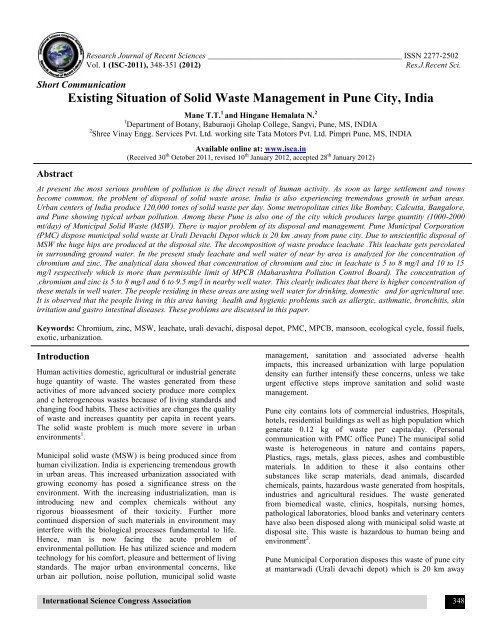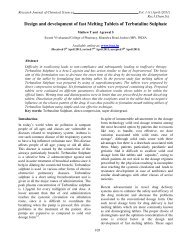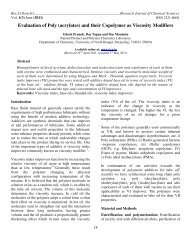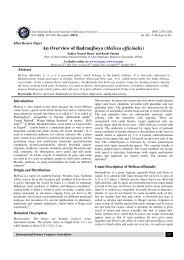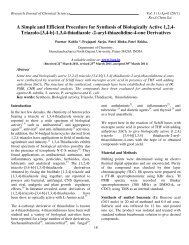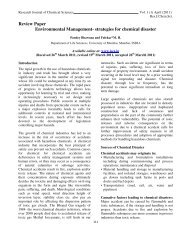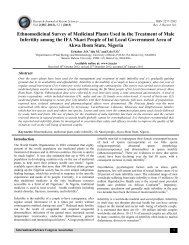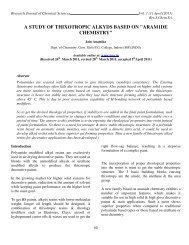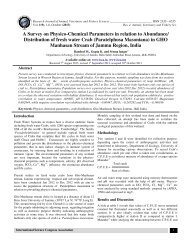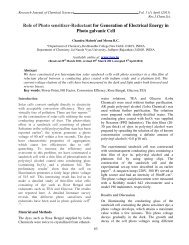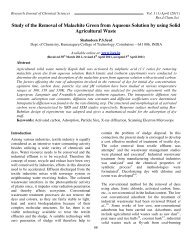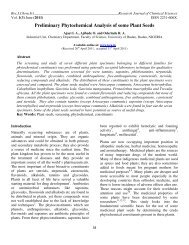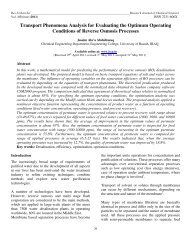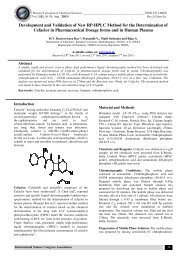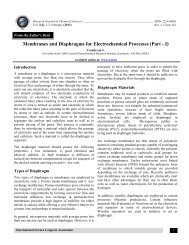Existing Situation of Solid Waste Management in Pune City ... - ISCA
Existing Situation of Solid Waste Management in Pune City ... - ISCA
Existing Situation of Solid Waste Management in Pune City ... - ISCA
Create successful ePaper yourself
Turn your PDF publications into a flip-book with our unique Google optimized e-Paper software.
Research Journal <strong>of</strong> Recent Sciences ________________________________________________ ISSN 2277-2502<br />
Vol. 1 (ISC-2011), 348-351 (2012) Res.J.Recent Sci.<br />
Short Communication<br />
<strong>Exist<strong>in</strong>g</strong> <strong>Situation</strong> <strong>of</strong> <strong>Solid</strong> <strong>Waste</strong> <strong>Management</strong> <strong>in</strong> <strong>Pune</strong> <strong>City</strong>, India<br />
Abstract<br />
Mane T.T. 1 and H<strong>in</strong>gane Hemalata N. 2<br />
1 Department <strong>of</strong> Botany, Baburaoji Gholap College, Sangvi, <strong>Pune</strong>, MS, INDIA<br />
2 Shree V<strong>in</strong>ay Engg. Services Pvt. Ltd. work<strong>in</strong>g site Tata Motors Pvt. Ltd. Pimpri <strong>Pune</strong>, MS, INDIA<br />
Available onl<strong>in</strong>e at: www.isca.<strong>in</strong><br />
(Received 30 th October 2011, revised 10 th January 2012, accepted 28 th January 2012)<br />
At present the most serious problem <strong>of</strong> pollution is the direct result <strong>of</strong> human activity. As soon as large settlement and towns<br />
become common, the problem <strong>of</strong> disposal <strong>of</strong> solid waste arose. India is also experienc<strong>in</strong>g tremendous growth <strong>in</strong> urban areas.<br />
Urban centers <strong>of</strong> India produce 120,000 tones <strong>of</strong> solid waste per day. Some metropolitan cities like Bombay, Calcutta, Bangalore,<br />
and <strong>Pune</strong> show<strong>in</strong>g typical urban pollution. Among these <strong>Pune</strong> is also one <strong>of</strong> the city which produces large quantity (1000-2000<br />
mt/day) <strong>of</strong> Municipal <strong>Solid</strong> <strong>Waste</strong> (MSW). There is major problem <strong>of</strong> its disposal and management. <strong>Pune</strong> Municipal Corporation<br />
(PMC) dispose municipal solid waste at Urali Devachi Depot which is 20 km .away from pune city. Due to unscientific disposal <strong>of</strong><br />
MSW the huge hips are produced at the disposal site. The decomposition <strong>of</strong> waste produce leachate .This leachate gets percolated<br />
<strong>in</strong> surround<strong>in</strong>g ground water. In the present study leachate and well water <strong>of</strong> near by area is analyzed for the concentration <strong>of</strong><br />
chromium and z<strong>in</strong>c. The analytical data showed that concentration <strong>of</strong> chromium and z<strong>in</strong>c <strong>in</strong> leachate is 5 to 8 mg/l and 10 to 15<br />
mg/l respectively which is more than permissible limit <strong>of</strong> MPCB (Maharashtra Pollution Control Board). The concentration <strong>of</strong><br />
.chromium and z<strong>in</strong>c is 5 to 8 mg/l and 6 to 9.5 mg/l <strong>in</strong> nearby well water. This clearly <strong>in</strong>dicates that there is higher concentration <strong>of</strong><br />
these metals <strong>in</strong> well water. The people resid<strong>in</strong>g <strong>in</strong> these areas are us<strong>in</strong>g well water for dr<strong>in</strong>k<strong>in</strong>g, domestic and for agricultural use.<br />
It is observed that the people liv<strong>in</strong>g <strong>in</strong> this area hav<strong>in</strong>g health and hygienic problems such as allergic, asthmatic, bronchitis, sk<strong>in</strong><br />
irritation and gastro <strong>in</strong>test<strong>in</strong>al diseases. These problems are discussed <strong>in</strong> this paper.<br />
Keywords: Chromium, z<strong>in</strong>c, MSW, leachate, urali devachi, disposal depot, PMC, MPCB, mansoon, ecological cycle, fossil fuels,<br />
exotic, urbanization.<br />
Introduction<br />
Human activities domestic, agricultural or <strong>in</strong>dustrial generate<br />
huge quantity <strong>of</strong> waste. The wastes generated from these<br />
activities <strong>of</strong> more advanced society produce more complex<br />
and e heterogeneous wastes because <strong>of</strong> liv<strong>in</strong>g standards and<br />
chang<strong>in</strong>g food habits. These activities are changes the quality<br />
<strong>of</strong> waste and <strong>in</strong>creases quantity per capita <strong>in</strong> recent years.<br />
The solid waste problem is much more severe <strong>in</strong> urban<br />
environments 1 .<br />
Municipal solid waste (MSW) is be<strong>in</strong>g produced s<strong>in</strong>ce from<br />
human civilization. India is experienc<strong>in</strong>g tremendous growth<br />
<strong>in</strong> urban areas. This <strong>in</strong>creased urbanization associated with<br />
grow<strong>in</strong>g economy has posed a significance stress on the<br />
environment. With the <strong>in</strong>creas<strong>in</strong>g <strong>in</strong>dustrialization, man is<br />
<strong>in</strong>troduc<strong>in</strong>g new and complex chemicals without any<br />
rigorous bioassesment <strong>of</strong> their toxicity. Further more<br />
cont<strong>in</strong>ued dispersion <strong>of</strong> such materials <strong>in</strong> environment may<br />
<strong>in</strong>terfere with the biological processes fundamental to life.<br />
Hence, man is now fac<strong>in</strong>g the acute problem <strong>of</strong><br />
environmental pollution. He has utilized science and modern<br />
technology for his comfort, pleasure and betterment <strong>of</strong> liv<strong>in</strong>g<br />
standards. The major urban environmental concerns, like<br />
urban air pollution, noise pollution, municipal solid waste<br />
management, sanitation and associated adverse health<br />
impacts, this <strong>in</strong>creased urbanization with large population<br />
density can further <strong>in</strong>tensify these concerns, unless we take<br />
urgent effective steps improve sanitation and solid waste<br />
management.<br />
<strong>Pune</strong> city conta<strong>in</strong>s lots <strong>of</strong> commercial <strong>in</strong>dustries, Hospitals,<br />
hotels, residential build<strong>in</strong>gs as well as high population which<br />
generate 0.12 kg <strong>of</strong> waste per capita/day. (Personal<br />
communication with PMC <strong>of</strong>fice <strong>Pune</strong>) The municipal solid<br />
waste is heterogeneous <strong>in</strong> nature and conta<strong>in</strong>s papers,<br />
Plastics, rags, metals, glass pieces, ashes and combustible<br />
materials. In addition to these it also conta<strong>in</strong>s other<br />
substances like scrap materials, dead animals, discarded<br />
chemicals, pa<strong>in</strong>ts, hazardous waste generated from hospitals,<br />
<strong>in</strong>dustries and agricultural residues. The waste generated<br />
from biomedical waste, cl<strong>in</strong>ics, hospitals, nurs<strong>in</strong>g homes,<br />
pathological laboratories, blood banks and veter<strong>in</strong>ary centers<br />
have also been disposed along with municipal solid waste at<br />
disposal site. This waste is hazardous to human be<strong>in</strong>g and<br />
environment 2 .<br />
<strong>Pune</strong> Municipal Corporation disposes this waste <strong>of</strong> pune city<br />
at mantarwadi (Urali devachi depot) which is 20 km away<br />
International Science Congress Association 348
Research Journal <strong>of</strong> Recent Sciences ____________________________________________________________ ISSN 2277 - 2502<br />
Vol. 1(ISC-2011), 348-351 (2012) Res.J.Recent.Sci<br />
from pune city. About 1200-1300 metric tones <strong>of</strong> solid waste<br />
from pune municipal area is disposed per day at Mantarwadi<br />
(Urali Devachi village). Dur<strong>in</strong>g the early period, MSW was<br />
conveniently disposed <strong>of</strong>f at Mantarwadi disposal site <strong>in</strong> low<br />
ly<strong>in</strong>g areas with large open land space. The unscientific<br />
disposal <strong>of</strong> solid waste created lots <strong>of</strong> environmental problem<br />
<strong>in</strong> this area. It resulted <strong>in</strong>to air pollution and ground water<br />
pollution problems. The Well water near to disposal site <strong>in</strong><br />
Urali Devachi village is now not safe for domestic use<br />
(dr<strong>in</strong>k<strong>in</strong>g, outdoor bath<strong>in</strong>g, propagation <strong>of</strong> aquatic life,<br />
<strong>in</strong>dustrial cool<strong>in</strong>g and for irrigation).<br />
It has been found that due to waste disposal the people liv<strong>in</strong>g<br />
<strong>in</strong> this area face many environmental and health problems.<br />
Material and Methods<br />
Information related to exist<strong>in</strong>g situation <strong>of</strong> solid waste<br />
management <strong>in</strong> pune city was collected from <strong>Pune</strong> Municipal<br />
Office. We also collected <strong>in</strong>formation related to health<br />
hazard from the public liv<strong>in</strong>g near by areas around the<br />
disposal site.<br />
Method <strong>of</strong> disposal: Figure-1 presently most <strong>of</strong> MSW <strong>in</strong><br />
pune is be<strong>in</strong>g disposed unscientifically. Generally MSW is<br />
collected and deposited <strong>in</strong> sanitary landfills. Such<br />
unscientific disposal practices attract birds, rodents and fleas<br />
to the waste dump<strong>in</strong>g site and create unhygienic conditions.<br />
The anaerobic decomposition by microorganisms br<strong>in</strong>gs<br />
about degradation <strong>of</strong> most <strong>of</strong> the solid waste. This results <strong>in</strong><br />
the emission <strong>of</strong> carbon dioxide (Co2), Methane (CH4) and<br />
other trace gases Methane gas Constitute about 60% <strong>in</strong> a<br />
solid waste landfill 2 .<br />
The general anaerobic transformation <strong>of</strong> solid waste with the<br />
help <strong>of</strong> microorganism can be describe by the follow<strong>in</strong>g<br />
equation<br />
Organic matter+H2O+Bacteria+ temperature new cells<br />
resistant organic matter+CO2+CH4+NH4+H2S (1)<br />
Under the reduc<strong>in</strong>g condition, sulfate reduce to sulfide which<br />
subsequently comb<strong>in</strong>es with hydrogen to form H2S<br />
2CH 3CHOHCOOH+SO 4 2 CH3COOH+S 2 +2H 2O+2CO 2 (2)<br />
4H2+SO4 2 S 2 +4H2O (3)<br />
S 2 +2H+ H2S Hydrogen sulfide 3 (4)<br />
Figure-2 Methane gas is explosive <strong>in</strong> nature and causes the<br />
burn<strong>in</strong>g <strong>of</strong> solid waste, thus giv<strong>in</strong>g rise to air pollution.<br />
Along with methane gas, many toxic, volatile air pollutants<br />
are emitted such as chlor<strong>in</strong>ate hydrocarbon compounds like<br />
v<strong>in</strong>yl chloride and tetra chloro ethylene from solid waste<br />
landfill 4 . It is found that these air pollutants have caused a<br />
plenthora health problem among residents nearby. Figure 2<br />
show<strong>in</strong>g the burn<strong>in</strong>g <strong>of</strong> waste <strong>in</strong> summer season due to<br />
<strong>in</strong>crease is temperature.<br />
The another problem arise due to unscientific disposal is the<br />
water pollution. Dur<strong>in</strong>g land fil<strong>in</strong>g <strong>of</strong> solid waste due to<br />
cont<strong>in</strong>uous pressure it results quizz<strong>in</strong>g <strong>of</strong> contam<strong>in</strong>ated liquid<br />
called as a leachate. Leachate is liquid emanat<strong>in</strong>g from a land<br />
disposal cell that conta<strong>in</strong>s dissolved, suspended and<br />
microbial contam<strong>in</strong>ants from the solid waste 2 . The leachate<br />
has high organic contents, soluble salts and other constituents<br />
capable <strong>of</strong> pollut<strong>in</strong>g ground water. It is proved that this<br />
polluted ground water is unfit for dr<strong>in</strong>k<strong>in</strong>g and causes health<br />
compla<strong>in</strong>ts like jaundice, nausea, asthma, miscarriage and<br />
<strong>in</strong>fertility 5 . Now a day it is realized that unscientific solid<br />
waste disposal practices is one <strong>of</strong> the reasons <strong>of</strong> global<br />
warm<strong>in</strong>g. So to study quality <strong>of</strong> air and to study physicochemical<br />
characteristics <strong>of</strong> the water <strong>of</strong> urali devachi village<br />
there is need to do air monitor<strong>in</strong>g as well as water analysis <strong>of</strong><br />
the disposal site.<br />
Physico-chemical analysis <strong>of</strong> well water and leachate:<br />
Sample collection: Leachate and ground water was collected<br />
from site <strong>in</strong> the month <strong>of</strong> June, and dec-2010 to Jan-2011.<br />
Dur<strong>in</strong>g the study grab and composite sampl<strong>in</strong>g methods are<br />
used for sample collection. Two heavy metals i.e. chromium<br />
and z<strong>in</strong>c were analyzed from leachate and ground water.<br />
Dur<strong>in</strong>g the study Leachate sampl<strong>in</strong>g were carried out two<br />
times <strong>in</strong> mansoon season and two times <strong>in</strong> w<strong>in</strong>ter season by<br />
us<strong>in</strong>g composite sampl<strong>in</strong>g method and well water sampl<strong>in</strong>g<br />
were carried out three times with<strong>in</strong> twelve months period<br />
from two different well by us<strong>in</strong>g grab sampl<strong>in</strong>g method.<br />
(One well is located 800 mtrs. away from landfill site &<br />
another well located 1200 mtrs. away from landfill site). The<br />
sample collected from the site was analyzed <strong>in</strong> Tata Motors<br />
Pvt. Ltd. laboratory pimpri.<br />
Analytical Methods: The concentration <strong>of</strong> chromium (mg/l)<br />
was carried out by diphenylcarbazid method with the help <strong>of</strong><br />
UV spectro photometer given <strong>in</strong> APHA-AWWA-WPCF. The<br />
concentration <strong>of</strong> z<strong>in</strong>c (mg/l) was carried out with the help <strong>of</strong><br />
dithioz<strong>in</strong>e method with the help <strong>of</strong> UV spectro photometer<br />
given <strong>in</strong> APHA-AWWA-WPCF.<br />
Location <strong>of</strong> sample collection: The samples <strong>of</strong> leachate<br />
have been collected from follow<strong>in</strong>g locations figure -3<br />
Sample 1: Leachate samples collected from percolation<br />
tanks no. 1, 2 and 3 <strong>in</strong> the month <strong>of</strong> June, 2010 (Photo 1)<br />
Sample 2: Leachate samples collected from percolation<br />
tanks no. 1, 2 and 3 <strong>in</strong> the month <strong>of</strong> Aug, 2010<br />
Sample 3: Leachate samples collected from percolation<br />
tanks no. 1, 2 and 3 <strong>in</strong> the month <strong>of</strong> Nov. 2010<br />
International Science Congress Association 349
Research Journal <strong>of</strong> Recent Sciences ____________________________________________________________ ISSN 2277 - 2502<br />
Vol. 1(ISC-2011), 348-351 (2012) Res.J.Recent.Sci<br />
Sample 4: Leachate samples collected from percolation<br />
tanks no. 1, 2 and 3 <strong>in</strong> the month <strong>of</strong> Dec,<br />
The samples <strong>of</strong> ground water have been collected from<br />
follow<strong>in</strong>g locations figure - 4 and 5<br />
Sample 1: i. Well water Sample collected <strong>in</strong> the month <strong>of</strong><br />
Jan.2010, (Well located 800 mtrs away from landfill site)<br />
(Photo No.2), ii. Well water collected <strong>in</strong> the month <strong>of</strong><br />
Jan.2010 (Well located 1200 mtrs away from landfill site)<br />
(Photo No. 3)<br />
Sample 2: i. Well water collected <strong>in</strong> the month <strong>of</strong> May.2010<br />
(Well located 800 mtrs away from landfill site) ii. Well water<br />
collected <strong>in</strong> the month <strong>of</strong> May.2010 (Well located 1200 mtrs<br />
away from landfill site)<br />
Sample 3: i. Well water collected <strong>in</strong> the month <strong>of</strong> Jul.2010<br />
(Well located 800 mtrs away from landfill site.) ii. Well<br />
water collected <strong>in</strong> the month <strong>of</strong> Jul.2010 (Well located 1200<br />
mtrs away from landfill site)<br />
Results and Discussion<br />
<strong>Pune</strong> municipal solid waste: From the overall study <strong>of</strong> solid<br />
waste management <strong>in</strong> pune city it is observe that <strong>Pune</strong> city<br />
generates about 1200-1300 metric tones <strong>of</strong> solid waste per<br />
day. This unsegregated solid waste is disposed at landfill site<br />
near Urali-Devachi village which is 20 km away from pune<br />
city. The 43 ha <strong>of</strong> land allocated for solid waste disposal,<br />
from which 15 ha area is already land filled and sealed <strong>of</strong>f<br />
permanently. Photo plate No. 4 shows the disposal site<br />
Mantarwadi (Urali Devachi). <strong>Solid</strong> waste generated at<br />
disposal site is <strong>of</strong> two types Biodegradable and Non-<br />
biodegradable is as follows.<br />
Figure-7 shows characteristics <strong>of</strong> waste for pune city. Out <strong>of</strong><br />
total garbage 70% waste is organic waste, 8% is paper waste,<br />
7% is plastic waste, 4% metal waste, 6% glass waste, and 5%<br />
miscellaneous waste. Figure-8 Organic waste <strong>in</strong>cludes<br />
leaves, timber waste, vegetable extract, kitchen waste,<br />
household waste, hotels waste, fruits and juice centre residue<br />
etc. Paper waste <strong>in</strong>cludes paper dish, news paper, paper box,<br />
paper bags, wrapp<strong>in</strong>g materials (e.g. soap cover, tooth paste<br />
cover, match box cover) etc. Plastic waste <strong>in</strong>cludes plastic<br />
bags, broken plastic material (e.g. mug, bucket, pipes, plastic<br />
covers, plastic wrapp<strong>in</strong>g material). Metal waste <strong>in</strong>cludes<br />
screw, nut bolt, electronic parts, damage vehicle parts etc.<br />
Glass waste <strong>in</strong>cludes broken glass materials, bear bottle,<br />
glass lamp, bulb, tube lights. Miscellaneous waste <strong>in</strong>cludes<br />
all sanitary waste.<br />
Figure-9 shows that source wise quantity generation <strong>of</strong> waste<br />
<strong>in</strong> percent at pune city. out <strong>of</strong> which 40% waste is domestic<br />
waste (household) waste, 25% waste is from commercial<br />
area, 5% waste is from market area, 25% waste is from<br />
hotels and restaurants and 5% waste is <strong>of</strong> vegetable waste.<br />
Recently this MSW is collected, transported from 14 ward<br />
that are Aundh, Ghole road, Warje, Karve nagar, Dhole-Patil<br />
ward, Yerwada, Sangamwadi, Bhavani peth, kasba,<br />
vishrambaug wada, Sahakar nagar, Tilak road, Bibwewadi,<br />
Dhankawadi and Hadapsar. The collected MSW waste is<br />
disposed at Urali Devachi site which is about 20km. away<br />
from <strong>Pune</strong>, at Devachi Urali. The total cost for collection,<br />
transportation and disposal is Rs. 60 crores per year.<br />
Physico-chemical analysis <strong>of</strong> leachate and water: From<br />
figure-10 and table-1 It is <strong>in</strong>dicate that the chromium with<strong>in</strong><br />
the leachate sample is exceeds the limit. chromium <strong>of</strong> sample<br />
no. III is more i.e. 8 mg/l. as compare to other sample. From<br />
this result it is <strong>in</strong>dicate that leachate sample conta<strong>in</strong><strong>in</strong>g high<br />
amount <strong>of</strong> chromium. Sample result ranges from 5 to 8 mg/l.<br />
From the figure-11 and table -1 it is observe that Z<strong>in</strong>c with<strong>in</strong><br />
the leachate sample is exceeds the limit. Z<strong>in</strong>c content <strong>of</strong><br />
sample no. II is more i.e. 15 mg/l. as compare to other<br />
sample. From this result it is <strong>in</strong>dicate that leachate sample<br />
conta<strong>in</strong><strong>in</strong>g high amount <strong>of</strong> Z<strong>in</strong>c. Sample result ranges from<br />
10 to 15 mg/l.<br />
From table-2 and figure-12 it is observe that the chromium<br />
with<strong>in</strong> the well water sample is exceeds the limit. chromium<br />
<strong>of</strong> sample A with<strong>in</strong> january month is more i.e. 8.2 mg/l. as<br />
compare to other sample. From this result it is <strong>in</strong>dicate that<br />
well water sample conta<strong>in</strong><strong>in</strong>g high amount <strong>of</strong> chromium.<br />
Sample result ranges from 5 to 8 mg/l.<br />
From table-2 and figure-13 it is observe that Z<strong>in</strong>c with<strong>in</strong> the<br />
well water sample is exceeds the limit. Z<strong>in</strong>c content <strong>of</strong><br />
sample A with<strong>in</strong> july month is more i.e. 9.5 mg/l. as compare<br />
to other sample. From this result it is <strong>in</strong>dicate that well water<br />
sample conta<strong>in</strong><strong>in</strong>g high amount <strong>of</strong> Z<strong>in</strong>c. Sample result ranges<br />
from 6 to 9.5 mg/l.<br />
The analytical data showed that concentration <strong>of</strong> chromium<br />
and z<strong>in</strong>c <strong>in</strong> leachate is 5 to 8 mg/l and 10 to 15 mg/l<br />
respectively which is more than permissible limit <strong>of</strong> MPCB<br />
(Maharashtra Pollution Control Board). The concentration <strong>of</strong><br />
chromium and z<strong>in</strong>c is 5 to 8 mg/l and 6 to 9.5 mg/l <strong>in</strong> nearby<br />
well water. (800 and 1200 meters away from landfill site)<br />
This clearly <strong>in</strong>dicates that there is higher concentration <strong>of</strong><br />
these metals <strong>in</strong> well water. The people resid<strong>in</strong>g <strong>in</strong> these areas<br />
are us<strong>in</strong>g well water for dr<strong>in</strong>k<strong>in</strong>g, domestic and for<br />
agricultural use. It is observed that the people liv<strong>in</strong>g <strong>in</strong> this<br />
area hav<strong>in</strong>g health and hygienic problems such as allergic,<br />
asthmatic, bronchitis, sk<strong>in</strong> irritation and gastro <strong>in</strong>test<strong>in</strong>al<br />
diseases.<br />
Conclusion<br />
From overall study and analysis is concluded that the solid<br />
waste disposal methods at Urali Devachi Depot<br />
International Science Congress Association 350
Research Journal <strong>of</strong> Recent Sciences ____________________________________________________________ ISSN 2277 - 2502<br />
Vol. 1(ISC-2011), 348-351 (2012) Res.J.Recent.Sci<br />
(Mantarwadi) generate many environmental as well as health<br />
hazards with<strong>in</strong> the surround<strong>in</strong>g area. It also causes harmful<br />
health effect on people liv<strong>in</strong>g <strong>in</strong> that area. Open dump<strong>in</strong>g <strong>of</strong><br />
solid waste affect the aesthetic value <strong>of</strong> the surround<strong>in</strong>g area<br />
<strong>of</strong> the disposal site. It also produces very bad smell at the<br />
time <strong>of</strong> decomposition process. At the time <strong>of</strong> decomposition<br />
it released a various gases with<strong>in</strong> the surround<strong>in</strong>g area due to<br />
that air get polluted and this pollution leads to global<br />
warm<strong>in</strong>g. All this gases e.g. SO2, CH4, CO2 etc. are very<br />
harmful to human health. The released <strong>of</strong> this beyond<br />
average limit causes disorders related to respiratory tract.<br />
Leachate formed from waste mixed with ground water and<br />
pollutes that water.<br />
Concentration <strong>of</strong> all parameters found <strong>in</strong> well water is<br />
exceeds the limit so it is not safe for dr<strong>in</strong>k<strong>in</strong>g, commercial<br />
used, irrigation and <strong>in</strong>dustrial purpose. These leachates have<br />
corrosive activity which is also dangerous for human health.<br />
So the dump<strong>in</strong>g ground not only affect environment but also<br />
damage the property <strong>in</strong> the vic<strong>in</strong>ity area. The current<br />
practices needs to improve for manag<strong>in</strong>g waste.<br />
Acknowledgement<br />
In humble reverence to god who is the most beneficent and<br />
the most merciful and whose benign benediction were with<br />
me through my work. I express my obligation from the core<br />
<strong>of</strong> my heart towards Mr. Chavan G. Director <strong>of</strong> the Shree<br />
V<strong>in</strong>ay Eng<strong>in</strong>eer<strong>in</strong>g Services Pvt. Ltd. for support <strong>of</strong> my<br />
research. Lastly I am thankful to all my friends and family<br />
members who shared my dream, encouraged me at every step<br />
& appreciated my work. It is not possible to thank them<br />
personally, but their contribution bears an <strong>in</strong>delible impr<strong>in</strong>t<br />
on my heart.<br />
References<br />
1. Y. Anjaneyula Introduction to Environmental<br />
Science (2005)<br />
2. Dhere A.M. and Pardeshi P.B., Municipal solid waste<br />
disposal <strong>in</strong> <strong>Pune</strong> city–Current science (95)6 (2008)<br />
3. Taylan V., Dahiya R.P., Anand S., and Sreekrishnan ,<br />
Quantification <strong>of</strong> Methane emission from <strong>Solid</strong> <strong>Waste</strong><br />
Disposal <strong>in</strong> Delhi, Journal <strong>of</strong> Resources,<br />
Conservation and Recycl<strong>in</strong>g, 3, 240-259 (2007)<br />
4. CPCB, <strong>Management</strong> <strong>of</strong> Municipal <strong>Solid</strong> <strong>Waste</strong>,<br />
Central Pollution Board: Delhi,<br />
(http://www.cpcb.com) (2000)<br />
5. Chian E.S.K., Stability <strong>of</strong> organic matter <strong>in</strong> landfill<br />
leachates, Water Res. 11, 225–232 (1977)<br />
6. Abdul-Wahab S.A., Model<strong>in</strong>g Methane and V<strong>in</strong>yl<br />
chloride <strong>in</strong> Soil surround<strong>in</strong>g landfill, International<br />
Journal <strong>of</strong> Environmental Pollution, 21, 339-349<br />
(2004)<br />
7. APHA, Standard Methods for exam<strong>in</strong>ation <strong>of</strong> water<br />
and waste water, American Public Health Association<br />
AWWA WCPF, Wash<strong>in</strong>gton, 17th Edition (1998)<br />
8. Baig S., Coulomb I., Courant P., Liechti P., Treatment<br />
<strong>of</strong> landfill leachate: Lapeyrouse and Satrod case<br />
studies. Ozone Sci. Eng, 21, 1–22 (1999)<br />
9. Baver L.D., and Gardner W.R., Soil Physics, John<br />
Willey and Inc., New York (1972)<br />
10. Baun D.L. and Christensen T.H., Speciation <strong>of</strong> heavy<br />
metals <strong>in</strong> landfill leachate: a review, <strong>Waste</strong> Manage.<br />
Res. 22, 3–23 (2004)<br />
11. Coim D.S., An Digestion <strong>of</strong> organic fraction <strong>of</strong><br />
Municipal solid waste, Indian Journal <strong>of</strong><br />
Environmental Health, 3, 193-196 (1997)<br />
12. Cotton A. and Ali M., Informal Sector waste<br />
recycl<strong>in</strong>g. 19 th Water, Sanitation (1993)<br />
13. EPTRI, Status <strong>of</strong> solid waste disposal <strong>in</strong> Metropolis<br />
Hyderabad, Environmental Protection Institute,<br />
Hyderabad (1995)<br />
14. El-Fadel M., F<strong>in</strong>dikakis A.N. and Leckie J.O.<br />
Environmental Impact <strong>of</strong> <strong>Solid</strong> <strong>Waste</strong> Land Fill<strong>in</strong>g,<br />
Journal <strong>of</strong> Environmental <strong>Management</strong>, 50, 1-25<br />
(1971)<br />
15. India States <strong>of</strong> the Environment, Hazardous waste:<br />
Special reference to Municipal <strong>Solid</strong> <strong>Waste</strong><br />
<strong>Management</strong>, 133-149 (2001)<br />
(http://cpcb.delhi.nic.<strong>in</strong>)<br />
16. Gosh P.C., Use <strong>of</strong> paper mill wastes water as a soil<br />
amendment <strong>of</strong> acid soils, Sci. and Cult., 32, 312-316<br />
(1966)<br />
17. Stegmann R. and Heyer K.U., Leachate management:<br />
leachate generation, collection, treatment and costs<br />
(2006)<br />
International Science Congress Association 351


